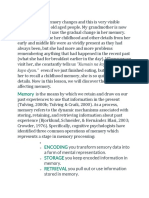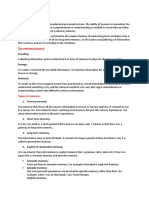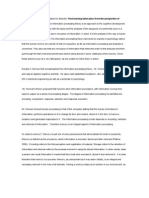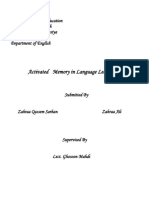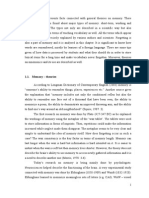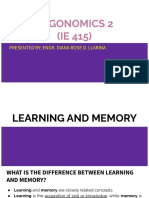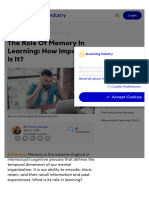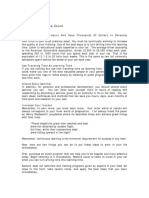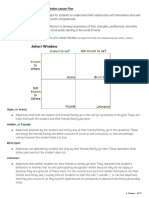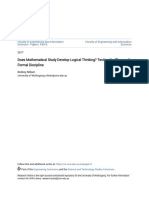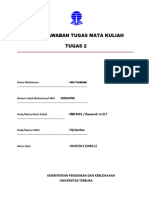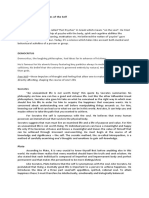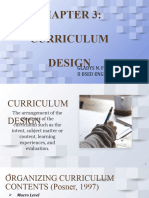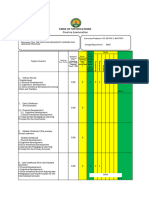Brain-Based Learning
Uploaded by
CHRISTINE ANDREA DE LARABrain-Based Learning
Uploaded by
CHRISTINE ANDREA DE LARAEuropean Journal of Education Studies
ISSN: 2501 - 1111
ISSN-L: 2501 - 1111
Available on-line at: www.oapub.org/edu
doi: 10.5281/zenodo.2612887 Volume 5 │ Issue 12 │ 2019
BRAIN-BASED AND LEARNING THEORIES:
APPLICATION OF THEORIES IN THE CLASSROOM
Harerimana Jean Paul
Dean of Students,
Mount Kenya University Rwanda,
Kigali, Rwanda
PhD Research Student
The Open University of Tanzania
Dar es Salaam, Tanzania
Abstract:
Memory and learning are inseparable concepts in education. Memory influences
learning, at the same time, Learning influences memory. This shows how Memory and
Learning are strongly linked. Memory is a well-organized Machine. Memory is
composed of systematic and well-coordinated structures. This implies that teaching and
learning process, to be successful, should take into consideration memory structures
and how it functions. Simply, teaching and learning must also be systematic and well-
organized to allow the memory to encode and retrieve information. The studies show
that memory can affect encoding and retrieval capacity. Teaching and learning are
meaningfully influenced and guided by brain-based and learning theories relevant to
teaching and classroom practices. Learning theories have significantly impacted
teaching strategies and they are relevant to learning in the classrooms. The learner’s
ability changes over time as a result of both maturation and experience. One of the most
important information processing capacities a child develops is the ability to organize
information. This is, in turn, influenced by the child’s ability to categorize. As is the case
with other information-processing capacities, this ability changes with both maturation
and experience. The level and stages of students are different. Students’ levels and
stages should be considered when preparing and delivering lessons in terms of content,
strategies, and teaching materials. The discussion and recommendations focused on the
important learning theories found to be influential in teaching and learning English
language: (1) Memory Storage and Retrieval Strengths theory; (2) Social Development
of Learning Theory; (3) Communicative Language Teaching Theory; (4) Game-Based
Learning Theory; (5) Family Influence Theory; (6) Zeigarnik and Interleaving Effect
Theory; (7) Perceptual Discrimination Theory; (8) Studying and Testing Theory; and (9)
The Theory of disuse.
Keywords: learning theory, brain, memory, teaching, learning, classroom
Copyright © The Author(s). All Rights Reserved.
© 2015 – 2019 Open Access Publishing Group 225
Harerimana Jean Paul
BRAIN-BASED AND LEARNING THEORIES: APPLICATION OF THEORIES IN THE CLASSROOM
1. Introduction
Memory is composed of systematic structures. Neisser (1967), one of the most
influential researchers in cognition, defines memory as the structure of how people
encode, structure, store, retrieve, use or otherwise learn knowledge. Memories have
retrieval and storage strengths. Storage strength can increase, but never decreases.
Carey (2014) explains the structure of brain and makes more understanding of
development on how the brain stores and retrieves. Carey identified the types of
memories (episodic, motor learning, and semantic) and their functions. She mentioned
that using our memories changes our memory. Some parts of our memory remain in
operations while we are at sleep, the left side of the brain is wordsmith and the right
side is the visual experts, and the fact that we have thousands brain modules that
performs several skills like calculating changes in light, tone of voice, and changes in
facial expression, and they all run at the same time.
Schacter and Tulving (as cited in Driscoll, 2001) state that “a memory system is
defined in terms of its brain mechanisms, the kind of information it processes, and the principles
of its operation” (p. 283). Carey (2014) in his book indicates the types of memories
(episodic, motor learning, and semantic) and their functions. Carey states that episodic
memory is used to remember events that take place over time like the first day of high
school. On the other hand, the semantic memory deals with facts rather than
experiences. Motor learning memory deals with the remembrances of physical skills
like swimming, kind of walking, and parading. Tulving’s (1972) theory of memory
draws a distinction between general knowledge (semantic memory) and memory for
events (episodic memory). Neuropsychological studies have generally examined each
type of memory in isolation, but theorists have long argued that these two forms of
memory are interdependent. Here we review several lines of neuropsychological
research that have explored the interdependence of episodic and semantic memory.
The studies show that these forms of memory can affect each other both at
encoding and at retrieval. Tulving’s influential theory proposes that human memory
can be divided into at least two subtypes. Tulving states that Semantic memory consists
of a “mental thesaurus” that provides “the memory necessary for the use of language” (p.
386), whereas episodic or autobiographical memory consists of memory for “temporally
dated episodes or events, and the temporal-spatial relations” among them (p. 385). Therefore,
Studies illustrate interdependencies between episodic and semantic memory at
encoding, but other work has shown that these forms of memory can interact at
retrieval as well. In a recent study (Greenberg, Keane, Ryan, & Verfaellie, 2009)
Carey (2014) mentions that the fact of using our memories changes our memory.
This indicates that every time we use and access memory, we change it a little bit. We
recall different details and intertwine the memory with other memories. The act of
finding and recalling memories increases the storage strengths and retrieval strengths.
Working hard to retrieve something will increase both storage and retrieve strengths
when we finally retrieve it. This principle is called desirable difficulty.
European Journal of Education Studies - Volume 5 │ Issue 12 │ 2019 226
Harerimana Jean Paul
BRAIN-BASED AND LEARNING THEORIES: APPLICATION OF THEORIES IN THE CLASSROOM
2. Discussion: Teaching and Learning Theories
Teaching and learning are meaningfully influenced and guided by brain-based and
learning theories relevant to teaching and classroom practices. Learning theories have
significantly impacted on teaching strategies and they are relevant to learning in the
classrooms. The discussion mainly focuses on the important learning theories found to
be influential in teaching and learning English language: (1) Memory Storage and
Retrieval Strengths Principles; (2) Social Development of Learning Theory; (3)
Communicative Language Teaching Theory; (4) Game-Based Learning Theory; (5)
Family Influence Theory; (6) Zeigarnik and Interleaving Effect Theory; (7) Perceptual
Discrimination Theory; (8) Studying and Testing Theory; and (9) The Theory of disuse.
A. Memory Storage and Retrieval Strengths Theory
The first theory mostly related to my classroom that is found relevant is the memory
storage and retrieval strengths principle. According to Carey (2014), “the first principle theory
is that any memory has two strengths, a storage strength and retrieval strength” (p.36). He
further added the desirable difficulty principle to support memory storage strength and
retrieval strengths: “the harder your brain has to work to dig out a memory, the greater the
increase in learning (retrieval and storage strength)” (p.82). In classrooms, memory storage
and retrieval strength are the mainly focused to ensure that students have captured,
and they can remember what they studied in classrooms. For instance, various
strategies are put into practice specifically Socratic questions, essays and open ended
questions are used to encourage students towards critical thinking. Formative tests to
students are part of learning and teaching to enable students remembering what they
have acquired and increase the storage and retrieval strengths. Immediate feedback is
also given to students to correct the. Additionally, students are given time to apply
what they have learnt in the real-life situation sing role plays, debates, and
presentations in classrooms. The preparation of the lesson before teaching helps me to
systematically organize information and deliver the content in steps in a such way that
it is easily captured by students following the steps of a lesson delivery (introduction,
development, application, and summary).
Carey (2014) stated that “learned information, without continued use, decays from
memory entirely” (p.29). Mixed practices are emphasized in my classrooms to fight
against the decay of information in the memory of students. Students are constantly
given assignment, continuous assessment tests, quizzes and homework. The
assignments given to students will be part of the discussion in the classrooms during
the correction and feedback is provided by the teacher. Carey added that ”the retrieval
strength increases with studying and with use. Without reinforcement, however retrieval
strength drops off quickly and its capacity is relatively small (compared to storage)” (p.37).
Reinforcement strategies are used to enable students store and retrieve information. For
example, identification and explanation of the key terms of the lesson, use of tables,
charts, diagrams, figures, pictures, revision before teaching and summary of lessons
after teaching are used in my classrooms to support students learning environment in
European Journal of Education Studies - Volume 5 │ Issue 12 │ 2019 227
Harerimana Jean Paul
BRAIN-BASED AND LEARNING THEORIES: APPLICATION OF THEORIES IN THE CLASSROOM
terms of memory storage and retrieval strengths. Houston (2001) analyzed the basis of
human learning and memory presented in theoretical and experimental psychological
research. According to Houston, retention processes cannot be separated from the
acquisition and transfer parts of the entire learning process defined as “a relatively
permanent change in behavior potentiality that occurs because of reinforced practice” (2001, p.
4). Repetition and reinforcement strategies are frequently used to ensure the smart
storage and retrieval of information.
English short stories constitute a good illustration of impact of teaching
strategies on the memory storage and retrieval strength. English short stories hold the
moral lesson to students which must be taught in a defined context. A short story like
Have You Filled a Bucket Today? A Guide to Daily Happiness for Kids, Carol McCloud is
taught in such way that can impact memory storage and retrieval capacity. McCloud
(2006) used a bucket filler to illustrate how being kind to others helps others to feel
happy. On the other hand, McCloud says that a bucket dipper is used to signify the
persons who is not kind to others and who does the actions that make others feel
unhappy or uncomfortable like using hurting words, and aggressive. The book outlines
the various moral lessons like caring, discipline, respect, kindness, social justice,
collaboration, thankfulness, love, positive attitude, consideration of family members,
taking care of old people, recognition, tolerance, self-discipline, self-control,
perseverance, creativity, love of family members, a strong work ethic, hardworking,
effort, civic quality like greeting the people in the community, human right respect,
helpfully, participation in the community, home, and school community services.
Therefore, as an English teacher, the explanation of the new or key words is very
important, the context, the denotation and connotation of words needs to be clear to
students, the metaphor used in the text, comparison, the central or subthemes themes of
the text, figures of speech, and summary of the text. Purposive selected questions are
asked to students to emphasize on critical thinking and application of the moral lesson
contained in the text. Carey (2014) stated that the contextual cues are very significant in
terms of memory storage and retrieval capacity. The comments and explanation of the
short story, as contextual cues, significantly add strength to storage and retrieval of the
memory. Therefore, the comments, contextualization, and explanations provide the
brain cues to store and retrieve more information about the short story and practice in
their real life.
B. Social Development of Learning Theory by Lev Vygotsky
The second theory that greatly influenced my classroom practices is social development
of learning. Lev Vygotsky was born in the U.S.S.R. in 1896. He lived during Russian
Revolution, a time of great change in his culture. Vygotsky, a well-known Russian
teacher and psychologist, is the originator of the social development theory of learning.
He proposed that social interaction profoundly influences cognitive development.
Vygotsky’s theory says that biological and cultural development does not occur in
isolation (Driscoll, 1994). Vygotsky (1962) assessed how the social environments
influence the learning process. He suggested that conducive learning occurs when
European Journal of Education Studies - Volume 5 │ Issue 12 │ 2019 228
Harerimana Jean Paul
BRAIN-BASED AND LEARNING THEORIES: APPLICATION OF THEORIES IN THE CLASSROOM
students interact with their peers, teachers, and other experts. Social learning theories
helps me to understand how people influence each other in English learning
environment. Effective language learning occurs in social contexts through interactions.
Social development theory of learning also informs teachers on how we can construct
active learning communities.
Vygotsky’s two important concepts raised up my consideration due to their
relevant practicability in the learner-centered English classrooms’ environment. The
concepts of Scaffolding and the Zone of Proximal Development provide a useful realistic
view of how students learn in one on one and group settings with the support of
competent persons. The concepts are relevant today in the sense that teachers are
supposed to act as facilitators and students get actively involved in their English
learning activities. Responsibility and involvement of students are very important and
significant in English learning environment. Lev Vygotsky’s theory is mainly focused
on how students actively learn through social interactions. The theory is learner-
centered oriented in its conception. Scaffolding is a metaphor which describes and
explains the role of the adult or more competent and knowledgeable peers in building
and guiding children’s learning and development activities (Hammond, 2002). The
popularity of scaffolding metaphor indicates its conceptual significance and practical
value for teaching and learning.
The term scaffolding metaphor expresses the effective role of quality teachers’
intervention in learning. On the other hand, the zone of Proximal development is at the
heart of Scaffolding. The Zone of Proximal Development bridges the gap between what
is known and what can be known. Vygotsky describes it as "the distance between the
actual development level as determined by independent problem solving and the level of potential
development as determined through problem solving under adult guidance or in collaboration
with more capable peers" (Vygotsky,1978). Vygotsky stated that learning occurs in this
zone. Additionally, Moalosi (2013) indicated that students cannot succeed alone in
classrooms’ social interactions. As they learn, they need to be helped in interacting with
more knowledgeable others. Through these interactions with adults or experienced peers,
students will learn how to tackle and solve different kinds of problems. This shows that
students need guidance of the competent teachers in social interactions and social
activities in the classrooms. The child can be thought of entering relations with the
situation, not directly but through the assistance of the other capable person. The theory
explains students’ successes when we look at learner-centered context that is created by
an adult who has a major role in the learning process (Moalosi, 2013).
Vygotsky’s social development theory of learning emphasized that students as
people are constructed by interacting with other people. Without interacting with more
knowledgeable others they may not succeed in their learning settings. As a teacher, the
theory is the most influential in English teaching and learning environment. The theory
joins forces to learner-centered approach’s role of the teacher who is a facilitator in
learning activities. In my English classroom, students learn from others through
collaboration, observation, imitation, experiments, practice and experiences. Therefore,
a gigantic responsibility, as a teacher, is always added to my practice to continually
European Journal of Education Studies - Volume 5 │ Issue 12 │ 2019 229
Harerimana Jean Paul
BRAIN-BASED AND LEARNING THEORIES: APPLICATION OF THEORIES IN THE CLASSROOM
create an English learning environment which enables students’ interactions and
exchanges of skills and knowledge. As facilitator, guidance and direction is very
important to ensure that students meticulously accomplish the task without challenges.
In my English classrooms, students practically interact through peer discussion,
debates, group work, collaboration, experiments, Socratic dialog, role play, engaging
questions, and constructive feedback from the teacher.
In secondary schools, adolescent needs intensive guidance and directions in the
English classroom activities. When the guidance and direction is minimal they can
deviate from the assignments given. For instance, when the group work assignment is
given in the classroom, the guidance is provided to each group to ensure that students
are doing the right things, at the right time, and at the right place. Group work
instructions are clearly defined and responsibilities allocated to each member of the
group to avoid role conflicts in group members. If students face challenges, under
guidance, the clarifications and explanations are given to students. This indicates that
students always receive the support from the competent and knowledgeable person, the
teacher, to effectively accomplish the collaborative activities in the classroom.
As a teacher of English language, a second language to my students, the
determination is to continually purpose to use social interaction activities in my
classrooms to expose my students to new language structures for language mastery and
development. This supports my teaching activities which aim at developing four
language skills specifically listening, reading, writing, and speaking. Vygotsky argued
that “language is the main tool that promotes thinking, develops reasoning, and supports
cultural activities like reading and writing" (Vygotsky 1978). Language is a socialization
agent and tool that enables people to interact and communicate. Through intensive and
systematic organized debates, presentations in classrooms, role plays, and group
discussions, students interact and share experiences in learning new language which is
English.
C. Communicative Language Teaching Theory
The modern approach in teaching languages which brings support to social
development of learning is communicative language teaching. Richards (2006) stated
that communicative language teaching involves the focus on important aspects such as
the use of language for different purpose and functions, the use of languages in formal
or informal speeches, maintaining communication, producing reports, interviews, and
conversations. He further mentioned that learners in communicative language teaching
views language teaching as mastery of communication. In my English classrooms,
students effectively learn when there is interaction between learners and users of the
language, collaborating and paying attention to the use of language in different
situations, and when trying it out and experimenting the way of saying things. Richards
specifies the activities that promote language mastery like dialogs, group discussion,
role plays, public speaking and presentations. Therefore, the social interaction with
guidance of the teacher is a constant support to communicative language teaching
activities for students’ language mastery. Languages are predominantly acquired from
European Journal of Education Studies - Volume 5 │ Issue 12 │ 2019 230
Harerimana Jean Paul
BRAIN-BASED AND LEARNING THEORIES: APPLICATION OF THEORIES IN THE CLASSROOM
sharing with others when it is used in the real-life situations. Corrections and
constructive feedback from the expert of the language is also very significant.
The social interactions in my English classrooms continually help my students to
develop the mastery of the language structure and speaking skills. This provides me a
huge responsibility of selecting appropriate class activities that involves social
interactions in classroom. The guidance must be recurrently planned and envisaged.
Vygotsky’s social development theory of learning provide rich guidance on how social
interactions in the classroom leads to the successful English classroom environment.
The teachers of English, as the experts of the subject, are recommended to be the
significant facilitators of the social interactions in their classroom when delivering the
content to students to insure the successful implementation of learning activities.
E. Game-Based Learning Theory
The forth learning theory that impacted my teaching practices in the classroom is game
based learning. The use of games in classroom significantly impacts students’ learning.
Perrotta et al. (2013) stated that game-based learning broadly refers to the use of games
to support teaching and learning. Additionally, game-based learning is defined as the
borrowing of certain gaming principles and applying them to real-life settings to
engage users or students’ in learning (Trybus, 2015). Trybus further stated that the
motivational psychology involved in game-based learning allows students to engage
with educational materials in a playful and dynamic way. Game-based learning is not
just creating games for students to play, it is designing learning activities that can
incrementally introduce concepts, and guide users towards an end goal. Games can
incorporate competition, points, incentives, and feedback. The concept has become
increasingly popular in education to engage students in learning.
Game-based learning closely connects the classroom activities to the real life. It
positively impacts the students’ learning experiences. It influences learning experiences
in a sense that it provides challenging opportunity to students, repetition, and the
rehearsal opportunity. The games are kinds of reinforcement activities. Games shape
the memory. Carey (2014) stated the principle of desirable difficulty which says that the
fact of using our memories changes our memory. This indicates that every time we use
and access memory, we change it a little bit. Games play a significant role to facilitate
the storage of information and increase the retrieval capacity of students.
Using game-based learning in the English classrooms, we provide opportunity to
students to continually use the information for a long time. The students find
opportunity to apply what they have learnt in the classroom. The preparation of games
keeps students at work and increase the storage and retrieval capability of memories.
Carey (2014) mentioned the theory of disuse which states that learned information
without continued use, decays from memory entirely. This means that game-based
learning support learning in the sense that information is continually used for a long
time. The game-based learning strategy also provides my students opportunity for
using mixed practice learning activities and creative problem solving. Carey
emphasized that varied practice in learning is more effective than the focused kind.
European Journal of Education Studies - Volume 5 │ Issue 12 │ 2019 231
Harerimana Jean Paul
BRAIN-BASED AND LEARNING THEORIES: APPLICATION OF THEORIES IN THE CLASSROOM
Varied practice works best in the long run for both motor and verbal learning. What
could be the best games that emphasize creative problem solving that we could
implement in our classrooms?
As an English language teacher, games are found very supportive in learning.
Games like Simon says, role play, sentence race, dialog, puzzles, and chain spelling,
meaningfully impact learning. Therefore, teachers are recommended to use games in
English language classrooms for supporting learning. Game-based learning is positively
supportive to learning environment. Students meaningfully learn in a social way. As a
teacher, there is a need to purposively select the gameplay that fits what is intended to
be taught in English language classrooms. Using games, learning happens by doing.
Game-based learning link the classroom activities to the real life. It positively impacts
the students’ learning experiences. To all the discussed theories, the family influence is
added and very significant to be considered by all teachers due to its influence on
children’s learning. Its influence is very important and linked to the academic success.
F. Family Influence Theory
The family also plays a significant role in the education of the children. Usher and
Kober (2012) stated that “research has long documented a strong relationship between family
background factors, such as income and parents’ educational levels, and student achievement.
Studies have also shown that parents can play an important role in supporting their children’s
academic achievement” (p.1). Additionally, Gottfried, Fleming, and Gottfried (cited in
Usher& Kober, 2012) explained that “research has shown a clear link between parent
involvement and children’s success in school. Studies have further demonstrated a correlation
between parent involvement and children’s educational development and subsequent intrinsic
academic motivation” (p.1). This validates that family background considerably
influences students’ academic performance.
There are three critical challenges to me as a teacher in my school on the need of
students and family background: (1) Many parents have not done pedagogical courses
to clearly identify their responsibility in education of their children and take care of the
needs of students; (2) the second critical challenge is that there are several factors that
can hinder parents from providing the full support to children’s education; (3) The third
critical challenge to me as a teacher in my school is that the majority of students come
from the families with parents that have financial constraints, and limited educational
attainment.
As a teacher, there are critical challenges related to the influence of the family on
students’ academic performance that have been challenging my teaching practices: The
first critical challenge was that parents are not specialized in all specific subject that the
students learn at school. However, parents can play the vital role by encouraging
students’ feelings of competence and control, and positive attitudes towards academic
success regardless their background (Grolnick, Friendly, and Bellas, cited in Usher&
Kober, 2012). Parents can promote the culture of good study habits at home; discuss the
reading materials with their children. Parents can also create and provide students’
opportunity to apply what they have learned from schools. They are also recommended
European Journal of Education Studies - Volume 5 │ Issue 12 │ 2019 232
Harerimana Jean Paul
BRAIN-BASED AND LEARNING THEORIES: APPLICATION OF THEORIES IN THE CLASSROOM
to set clear and rigorous rules about homework, television watching, use of social
media and internet, and use of mobile phones. If not controlled, they can become the
source of distraction to students and wastage of time to students (Ferguson, cited in
Usher& Kober, 2012). Many parents have not done pedagogical courses to clearly
identify their responsibility in education of their children. As a teacher in my school, I
have a huge responsibility to support parents and organize the regular meetings or
training with parents to remind them their key responsibility in education of their
children to influence their academic success in schools. If possible, as a teacher, my
purpose or wish is to create a brochure that highlights the parents’ role in education of
their children. With clear guidance, parents can certainly improve in supporting their
children.
The second critical challenge to my work as a teacher is that there are several
factors that constitute hindrances to parents from providing the full support to their
children. Therefore, parents need to identify and overcome the barriers that can hinder
the provision of full support to their children. Today, the work, overtime work, and
other activities have become stressors, and time consumers. The outside stressor, time
and resource constraints, divorce, and unfamiliarity with the role that parents can play
in education have significantly increased (Grolnick, Friendly, and Bellas, cited in
Usher& Kober, 2012). As a teacher, there is a need to conduct meetings with parents for
sensitizing their role and responsibility in education of their children. Additionally,
training will be organized on how parents can balance the work and the home activities
to find time for their children and motivate students towards academic success.
The third critical challenge to my school is that most students come from the
families with parents that have financial constraints, and limited educational
attainment. Some parents do not have sufficient financial resources to support their
students and some parents have limited educational attainment or some have not
attended the school at all. Children from disadvantaged families tend to have fewer
opportunities at home to foster competence, encourage them to find interest or see
value in learning, promote autonomous learning, or develop social relationships that
support and value achievement (Usher & Kober, 2012). Some parents in my school do
not value education of their children due to the limited educational attainment. Despite
those limitations, parents should continue to provide stimulating environments and
support to children. Even if there financial and educational attainment limited, there is
a need to be reminded their responsibility that they have in education of their children.
Usher and Kober (2012) stated that “a research found that a cognitively stimulating
environment is a more accurate determinant of children’s academic motivation than
socioeconomic status” (p.5). Therefore, there is a huge responsibility to continue
collaborating with parents and reminding them their supportive role in the provision
and creation of home stimulating environments towards academic success of their
children.
European Journal of Education Studies - Volume 5 │ Issue 12 │ 2019 233
Harerimana Jean Paul
BRAIN-BASED AND LEARNING THEORIES: APPLICATION OF THEORIES IN THE CLASSROOM
G. Zeigarnik and Interleaving Effect Theory
Carey (2014) explained two principles: Zeigarnik effect, mixed practices or varied practices
(interleaving effect). The first principle named Zeigarnik effect lead to improvement of
the learning process, and the second is related to the role and benefits of mixed
practices or varied practices (interleaving effect). This has really pushed me to ask
myself the two important questions which are related to learning and teaching
profession as well. The first question is about what contribution is made by Zeigarnik
effect to the improvement of the learning process, and the second question is what role
and benefits plays mixed practices or varied practices (interleaving effect) in learning.
Zeigarnik Effect significantly contributes to learning. Hammadi and Qureishi
(2013) indicated that Zeigarnik Effect is coined after a research made by a Russian
psychologist Dr. Bluma Zeigarnik. Zeigarnik Effect explains that people tend to
remember unfinished tasks better than finished tasks. When a job is left incomplete it
creates a sort of tension and irritation which begs for closure, thus, making it hard for
human beings to forget. Zeigarnik effect triggers suspense; a feeling of doubt and
nervousness about the result of certain events which keeps the audience glued to a
certain situation begging for closure, thus, making it hard for human beings to forget.
The teachers are advised to consider longer term assignment that students can devote
some time to on a regular basis. After studying explanation about Zeigarnik effect, what
could be the best and specific teaching strategies that teachers can implement in the
classrooms related to Zeigarnik effect in order to improve learning process and keep
students active in learning?
Learning interruption has been demonstrated as useful learning strategies and
technique that can improve comprehension and retention learning. The strategy is also
demonstrated as the best to keep students actively involved in learning by working on
unfinished work. Carey (2014) stated that Zeigarnik’s studies on interruption revealed
that a couple of the mind’s intrinsic biases, or built-in instincts when it comes to goals.
He further mentioned that the act of starting a job or a work on the assignment often
gives that job the psychological weight of the goal, even if it is meaningless. The second
result is that when the work is interrupted in an assignment extends its life in memory
and according to Zeigarnik effect, the interruption pushes the assignment to the top of our
mental to-do list. This kind of interruption creates suspense and pushes the unfinished
project to the top of our mind, leaving us to wonder what comes next. Studies show that
we remember more about the tasks that are unfinished than things we have finished. It
means that we have a mental do list of the unfinished jobs and unsolved problems that
are actively percolating unconsciously (building something what was not there before).
This simply means that the interruptions, controlled or uncontrolled, can promote the
problem solving and creativity.
Mixed practices or interleaving. The second problem that was raised when reading
the part related to problem solving is the role and benefits of varied practices in
learning or interleaving effect. Mixed practices or interleaving is better than focusing on
the same material or skill for extended period. If students are given the same kind of
questions like in mathematics, students will not make effort to determine the necessary
European Journal of Education Studies - Volume 5 │ Issue 12 │ 2019 234
Harerimana Jean Paul
BRAIN-BASED AND LEARNING THEORIES: APPLICATION OF THEORIES IN THE CLASSROOM
strategy. Transfer is what learning is all about. Carey (2014) states that varied activities
or practices are more effective than the focused kind. The varied practices force us to
internalize the general rules of motor adjustment that apply to any hittable target. He
further indicates that varied practices, not just repetitive practices, and works best in the
long run for both motor and verbal learning. Interleaving is a useful form of varied
practice: the mixing of items, skills, or concepts during practice over the longer term,
seems to help us not only see the distinctions between them but also to achieve the
clearer grasp of each one individually. The hardest part is abandoning our primal faith
in repetition. The interleaving means mixing related but distinct material during the
study. Varied practices in a lesson enhance the performance. Interleaving prepares the
brain for unexpected and life’s curveballs in general. This has raised my great concern
of what specific strategies or tips that a teacher can follow in order to effectively
implement varied practices in learning or interleaving effect. What long term benefits of
varied practices in learning or interleaving effect to the students’ learning?
H. Perceptual Discrimination Theory
Perceptual discrimination is defined as “the process of how brain learns to detect minute
differences in sights, sounds, or textures” (Carey, 2014, p.180). Gibson’s (1969) explained
that Perceptual discrimination in learning entails an increased ability to extract relevant
information from a stimulus array as the result of experience. Perceptual discrimination
in learning is an increased ability to detect information specifying affordances, events,
and distinctive features. In Gibson’s (1992) view, “perceptual learning is first and foremost
a process of selection” (p. 217). Perceptual information becomes increasingly
differentiated and specific to the self, the world, and the relations between them.
Gibson’s (1969) theoretical position, a perceptual differentiation theory, is that
perceptual learning is learning to extract information out of the sensory data of the
environment. The environment is seen as supplying an abundance of information. To
make sense of the sensory input a person must learn how to respond to distinctive
features of the stimuli. Perceptual learning, then, according to Gibson, has two
components: First, the person must learn what the distinctive features are. Second, the
person must learn how to use the distinctive features to discriminate different relevant
objects.
Carey (2014) mentioned that brain perceives to learn. It takes the differences
detected between similar looking notes or letters or figures and uses those to help
interpret new.
As a teacher of language, I found the implication of perceptual discrimination in
my lessons when I teach phonetic and phonology specifically minimal pairs. I have to
deal with various distinctive features. Minimal pair is a pair of words, differing only
sound in the same position in each word, especially when such a pair is taken as
evidence for the existence of a phonemic contrast between the two sounds. It is a set of
minimally contrasting words like /pɪn/ vs /bɪn/ vs /tɪn/ vs /dɪn/ vs /kɪn/. When teaching
minimal pairs, I emphasize distinctive features, for example, through the use of clearly
contrasting examples. Students learn to discriminate among the different sounds.
European Journal of Education Studies - Volume 5 │ Issue 12 │ 2019 235
Harerimana Jean Paul
BRAIN-BASED AND LEARNING THEORIES: APPLICATION OF THEORIES IN THE CLASSROOM
Additionally, I help the students to identify some of the distinctive features; for
example, pointing out cues for the student to discriminate between sounds. Then
through the systematic use of contrasting examples the students would be given
practice using the distinctive features to make the required discriminations. This has
really pushed me to ask myself how best and when I can also teach literature materials
and classes basing on perceptual discrimination theory. In short, the potential is three-
fold. Firstly, students learn better when I use examples which show differences and
contrasts. Secondly, students use senses for discrimination learning and detecting
minute differences between sounds in phonetics and phonology. Lastly, the brain
provides meaning by establishing connections between stimuli and responses. Students
learn better when the associates similar or previous learned objects.
I. Studying and Testing Theory
Testing is part of learning process. Teachers’ use testing strategies for different purpose
namely grading, checking the level of understanding and achievement of lesson
objectives, promotion, and repetition. Carey (2014) recommended that the use of test
should be a study technique not just for only measurement instrument. Therefore,
teachers could have the responsibilities of organizing tests in their teaching as an
instrument for learning improvement. Roediger et al. (2001) stated that Testing in
schools is usually thought to serve only the purpose of evaluating students and
assigning them grades. However, the main focus of testing that occurs in the classroom
can be viewed as part of the course or self-testing that students may use themselves as a
study strategy for improving performance. It was further emphasized that testing one’s
memory enhances long-term retention (Glover, 1989). This indicates that testing can be
the best strategy to increase students’ retention.
In my school, testing is part of our leaning activities. Both summative and
formative testing are purposively implemented in classrooms. For formative
assessment, the teacher is supposed to conduct the assessment before, during, and after
teaching a particular lesson for measuring the attainment of objectives, checking
understanding and retention. On the other hand, summative assessment is done after a
specific period of time during learning process like the examination conducted at the
end of the term, completion of the ordinary level, and advanced level for obtaining a
senior six certificate.
Some useful recommendations are made to my school administration in order to
change and improve the testing procedures’ efficiency, strategies and results. The major
recommendations are as follows: testing is a constant part of studying not only
instruments for promotion and measurement purposes, the revision time and breaks
are likely to be increased for students, the students should be explained about how to
facilitate and enhance good study habits, the study environment for test should be
conducive, the formative assessment should use various retention strategies,
downsizing overpopulated classroom, standard questions for both objective and open-
ended questions should be used, marking should not take long and quick feedback
should be provided to students for improvement and restudying.
European Journal of Education Studies - Volume 5 │ Issue 12 │ 2019 236
Harerimana Jean Paul
BRAIN-BASED AND LEARNING THEORIES: APPLICATION OF THEORIES IN THE CLASSROOM
The school administrator should take responsibilities for informing teachers that
testing is part of studying. Testing is part of studying not only for promotion and
measurement purposes. The school administrator is invited to change the purpose of
testing in classrooms. The current situation is that the test is organized for measurement
and categorization of students. Roediger et al. (2001) stated that the act of retrieving
when taking a test makes the tested material more memorable, either relative to no
activity or compared to restudying the material. Continuous assessment should be
strengthened in classrooms for formative purpose and emphasize that students’
retention.
Time for revision needs to be increased. Sometimes students’ needs enough time for
revision. Most of the time, students’ time for revision is not considered to be likely
enough. There is a time when students must sit for three tests per day. Carey (2014)
mentioned that frequent study breaks are more effective for learning and retention. He
further explains the distributive learning or spacing out the learning has a long-term
effect on learning and retention. The communication between administration and
teachers should be improved to avoid overloading our students and increase their time
of revision.
Good study habits guidance sessions are recommended to school administrators.
The students should be explained and guided on how to facilitate good study habits.
The school administration should regularly organize good study habits guidance for
students. Students needs to be taught how, when, what, why to learn in order to
succeed in the tests. Effective preparation matters a lot for students’ success and
improvement. Carey (2014) recommended some good study habits. The study habits
should be consistent form day 1 to the final testing. Breaks are very important for self-
study and students should avoid distractions during revision time. Additionally, the
school should ensure that the learning environment for students is conducive without
distractions, noise, sounds, and any other kind of disturbance. Students’ time for
retention is increased, when students are a conducive learning environment.
Testing and marking habits need to be improved. Some teachers take a lot of time
for making and giving feedback to students. This can hinder the real purpose of testing
which is studying. The school administration should make sure that tests are timely
marked, and feedbacks are timely give to students for facilitating improvement and
learning process. Carey (2014) recommended that the use of test should be a study
technique not just for only measurement instrument. Students will improve once
feedback is given to them. The opportunity for repeated study, learners may use a test
as feedback in order to make better use of subsequent study sessions (Thompson,
Wenger, & Bartling, 1978).The feedback will give opportunity to teachers for re-teach
what is not well understood and students will take time to re-learn what is not fully
retained.
Downsizing the class population should be also considered for improvement of
testing strategies. Student-Teacher ratio is too high. The teacher takes care of 50
students in classroom. This can constitute the barrier to the testing habits. Teachers are
overloaded with work and students’ work to mark. This cannot help teachers in terms
European Journal of Education Studies - Volume 5 │ Issue 12 │ 2019 237
Harerimana Jean Paul
BRAIN-BASED AND LEARNING THEORIES: APPLICATION OF THEORIES IN THE CLASSROOM
of marking. Teachers take time for marking due to the high number of students to
mark. The feedback is not timely given to students for improvement. The reduction of
teaching workload for providing enough time for marking is also recommended. The
teaching workload is too huge for teachers. The teachers are over loaded with teaching.
Little time is provided for marking. Lastly, proof reading of question papers is
recommended to minimize typing errors and insure standard of testing. Some teachers
set substandard examinations with grammatical errors and without clear instructions.
This can mislead students’ comprehension in the examination.
J. The Power of Forgetting: The Theory of disuse
The Power of Forgetting: A New Theory of Learning. Carey (2014) states that forgetting
is part of the process that leads to remembering things in the long run. Learning is
focused forgetting. Forgetting creates a room for new updated information. The theory of
disuse states that learned information without continued use, decays from memory
entirely. Additionally, Carey says that memory can improve for information nested in
stories or poetry. Reminiscence is also strong for visual information. Memories have
retrieval and storage strengths. Storage strength can increase, but never decreases.
Retrieval is fickle. It can build and weaken quickly. The theory is that no memory is
lost, it is currently not accessible due to lack of retrieval strengths. To increase the
retrieval strengths, information must be reinforced. A certain amount of forgetting also
stimulates us to study again in order to strengthen the information we had begun to
forget and much of associated information as well.
3. Conclusion and Recommendations
1) Memory is a well-organized Machine. Memory is composed of systematic
structures. Neisser (1967), one of the most influential researchers in cognition,
defines memory as the structure of how people encode, structure, store, retrieve,
use or otherwise learn knowledge. The memory has subdivisions with
specialized functions. This provides guidance on how teaching activities should
be systematically organized. Lesson plans and delivery should follow
systematically organized steps of a lesson: introduction, body, and evaluation.
The curriculum should be taught in sequences considering the prerequisite of the
previous lesson that is needed before teaching new concepts.
2) Memories have retrieval and storage strengths. Storage strength can increase, but
never decreases. To increase the retrieval strengths, information must be
reinforced. Basing on the important role of reinforcement for strengthening the
storage, teachers should use reinforcement activities in teaching like association
of similar ideas, visual support, graphics, figures, diagrams, pictures, and videos.
3) Consider different levels and stages of students in learning. Lutz and Huitt (2003)
state that structuring and organizing information occur as the learner processes
and stores information. The learner’s ability changes over time as a result of both
maturation and experience. One of the most important information processing
European Journal of Education Studies - Volume 5 │ Issue 12 │ 2019 238
Harerimana Jean Paul
BRAIN-BASED AND LEARNING THEORIES: APPLICATION OF THEORIES IN THE CLASSROOM
capacities a child develops is the ability to organize information. This is, in turn,
influenced by the child’s ability to categorize. As is the case with other
information-processing capacities, this ability changes with both maturation and
experience. One of the basic types of categorization is the grouping of specific
events, ideas, people, and things into concepts. The level and stages of students
are different. Students’ levels and stages should be considered when preparing
and delivering lessons in terms of content, strategies, and teaching materials.
4) Regular recapitulative and continuous assessment test in my classrooms. The theory of
disuse states that learned information without continued use, decays from
memory entirely. This provides me the opportunity for organizing regular
recapitulative and continuous assessment test in my classrooms to reinforce the
memory storage capacity of what I teach.
5) Using several reinforcement activities. The students in my classroom are different in
terms of storage and retrieval capacity. We have quick and slow learners. To our
students, we have learnt that storage strength can increase, but never decreases.
Retrieval is fickle. This shows that all students in the classroom have the storage
capacity, but they have different retrieval capacity. We need to reinforce their
retrieval capacity using several reinforcement activities for insuring the best
storage like exercises, figures, pictures, images, and diagrammes.
6) Testing and Marking. Testing is a constant part of studying. It is not only
instruments for promotion and measurement purposes, the revision time and
breaks. Both summative and formative testing are purposively implemented in
classrooms. For formative assessment, the teacher is supposed to conduct the
assessment before, during, and after teaching a lesson for measuring the
attainment of objectives, checking understanding and retention. Marking should
not take long, and quick feedback should be provided to students for motivation,
improvement and restudying.
7) Family involvement in school activities. Above mentioned. Studies have further
demonstrated a correlation between parent involvement and children’s
educational development and subsequent intrinsic academic motivation. There is
a huge responsibility to continue collaborating with parents and reminding them
their supportive role in the provision and creation of home stimulating
environments towards academic success of their children.
8) Games influence learning. Game-based learning closely connects the classroom
activities to the real life. It positively impacts on the students’ learning
experiences. It influences learning experiences in a sense that it provides
challenging opportunity to students, repetition, and the rehearsal opportunity.
The games are kinds of reinforcement activities. Games shape the memory. The
concept has become increasingly popular in education to engage and motivate
students in learning.
9) Social interactions in Learning. Vygotsky’s social development theory of learning
emphasized that students as people are constructed by interacting with other
people. Without interacting with more knowledgeable others they may not
European Journal of Education Studies - Volume 5 │ Issue 12 │ 2019 239
Harerimana Jean Paul
BRAIN-BASED AND LEARNING THEORIES: APPLICATION OF THEORIES IN THE CLASSROOM
succeed in their learning settings. Through intensive and systematic organized
debates, presentations in classrooms, role plays, and group discussions, students
interact and share experiences in learning.
About the Author
Mr. Harerimana Jean Paul is trained to be a Primary and Secondary school Language
teacher. He is also trained to be a school and Educational manager as well as inclusive
educational Lecturer. He worked as a Professional Teacher, Lecturer, Head of
Department, Dean of School of Education in Mount Kenya University; Dean of
Academics in Mahatma Gandhi University, and Educational Consultant in British
Council and VVOB (Flemish Association for Development Cooperation and Technical
Assistance). He currently works in Mount Kenya University Rwanda as a Lecturer and
Dean of Students. The areas of his interest, specialization, and teaching are English and
French Languages, Educational Planning, Management, Leadership, Administration,
Policy planning, Curriculum Development, Inclusive and Special Education.
References
Carey, B. (2014). How we learn. New York: Random House
Driscoll, M. (2001). Psychology of learning for assessment (2nd ed). Boston: Allyn and
Bacon.
Driscoll, M.P. (1994). Psychology of Learning for Instruction. Needham, Ma: Allyn &&
Bacon.
Ferguson, R.F. (2007b). Parenting practices, teenage lifestyles, and academic
achievement among African American children. Focus, 25, 18-26.
Gibson, E.J. (1969). Principles of perceptual learning and development. New York: Appleton-
Century Crofts.
Gibson, E.J. (1992). How to think about perceptual learning: Twenty-five years later. In H.L.
Pick, P. van den Broek & D.C. Knill (Eds.), Cognition: Conceptual and
methodological issues (pp. 215- 237). Washington, D.C.: American Psychological
Association.
Glover, J.A. (1989). The “testing” phenomenon: Not gone but nearly forgotten. Journal of
Educational Psychology, 81, 392–399.
Gottfried, A.E., Fleming, J.S., & Gottfried, A.W. (1994). Role of parental motivational
practices in children’s academic intrinsic motivation and achievement. Journal of
Educational Psychology, 86(1), 104-113.
Greenberg, D.L., Keane, M.M., Ryan, L.R. & Verfaellie, M. (2009). Impaired category
fluency in medial temporal lobe amnesia: The role of episodic memory. Journal of
Neuroscience, 29, 10900 –10908.
Grolnick, W.S., Friendly, R.W., & Bellas, V.M. (2009). Parenting and children’s
motivation at school. In K.R. Wentzel & A. Wigfield (Eds.), Handbook of motivation
at school, 279- 300. New York & London: Routledge.
European Journal of Education Studies - Volume 5 │ Issue 12 │ 2019 240
Harerimana Jean Paul
BRAIN-BASED AND LEARNING THEORIES: APPLICATION OF THEORIES IN THE CLASSROOM
Hammond, J. (2002). Scaffolding Teaching and Learning in Language and Literacy Education.
Newtown, Australia: PETA
Houston, J.P. (2001). Fundamentals of learning and memory, 4th ed. Fort Worth, TX:
Harcourt Brace Jovanovich College Publishers.
Lutz, S., & Huitt, W. (2003). Information processing and memory: Theory and applications.
Educational Psychology Interactive. Valdosta, GA: Valdosta State University.
Retrieved [date], from http://www.edpsycinteractive.org/papers/infoproc.pdf
McCloud, C. (2006). Have you filled a bucket today? A guide to daily happiness for kids.
Northville, MI: Nelson Publishing & Marketing.
Moalosi, W.T.S. (2013). Assessing Vygotsky’s Model for Students Learning. Educational
Research International Educational Research International, 2(3), 1-4. Retrieved from
http://www.erint.savap.org.pk/PDF/Vol.2(3)/ERInt.2013(2.3-06).pdf
Neisser, E. (1967). Cognitive psychology. New York: Appleton-Century-Crofts
Perrotta, C., Featherstone, G., Aston, H. & Houghton, E. (2013). Game-based Learning:
Latest Evidence and Future Directions (NFER Research Programme: Innovation in
Education). Slough: NFER
Richards, J.C. (2006). Communicative Language Teaching Today. Cambridge: Cambridge
University Press. Retrieved on October 13, 2016 from
file:///C:/Users/JEAN%20PAUL/Downloads/Richards-Communicative-
Language.pdf
Roediger, H.L., Putnam, A.L & Smith, M.A. (2011). Ten Benefits of Testing and Their
Applications to Educational Practice. Psychology of Learning and Motivation, 55, 1-6
DOI 10.1016/B978-0-12-387691-1.00001-6
Shelf Awareness (Psychology & Self-Help). How We Learn: The Surprising Truth About
When, Where, and Why It Happens by Benedict Carey. Retrieved from
http://www.shelf-awareness.com/readers-issue.html?issue=330#m5835
Stefánsson, E., G. (2013). Second Language Acquisition: The Effect of Age and Motivation.
Leiðbeinandi: Ásrún Jóhannsdóttir.
http://skemman.is/stream/get/1946/15018/35741/1/BA_EinarG.pdf
The New York Times Book Review. (2015). New Books for Psychiatry & Psychology Courses.
How We Learn: The Surprising Truth About When, Where, and Why It Happens
by Benedict Carey. Retrieved from https://www.randomhouseacademic.com/wp-
content/uploads/2015/05/2015RHAPSYCHBROCHURE.pdf
Thompson, C.P., Wenger, S.K., & Bartling, C.A. (1978). How recall facilitates subsequent
recall: A reappraisal. Journal of Experimental Psychology: Human Learning and
Memory, 4, 210–221.
Trybus, J. (2015). “Game-Based Learning: What it is, Why it Works, and Where it’s Going.”
New Media Institute. Retrieved December 1, 2016 from http://www.newmedia.org
/game-based-learning--what-it-is-why-it -works-and-where-its-going.html.
Tulving, E. (1972). Episodic and semantic memory. In E. Tulving & W. Donaldson
(Eds.), Organization of memory (pp. 381 –403). New York: Academic Press
Usher, A., & Kober, N. (2012). What roles do parent involvement, family background, and
culture play in student motivation? Manuscript submitted for publication, Graduate
European Journal of Education Studies - Volume 5 │ Issue 12 │ 2019 241
Harerimana Jean Paul
BRAIN-BASED AND LEARNING THEORIES: APPLICATION OF THEORIES IN THE CLASSROOM
School of Education and Human Development, George Washington University,
Washington, D.C. Retrieved December 4, 2015 from
https://cupo.blackboard.com/bbcswebdav/pid-548039-dt-content-rid-
6766343_1/courses/20172021812-
cup/resources/week5/W5_WhatRolesDoParentInvolvement.pdf
Vygotsky, L.S. (1978). Mind in Society: The development of higher psychological processes.
Cambridge, MA: Harvard University Press.
Vygotsky, L.S. (1962). Thought and Language. Cambridge, MA: MIT Press.
Vygotsky, L.S. (1978). Mind in Society: The development of higher psychological processes.
Cambridge, MA: Harvard University Press.
European Journal of Education Studies - Volume 5 │ Issue 12 │ 2019 242
Harerimana Jean Paul
BRAIN-BASED AND LEARNING THEORIES: APPLICATION OF THEORIES IN THE CLASSROOM
Creative Commons licensing terms
Author(s) will retain the copyright of their published articles agreeing that a Creative Commons Attribution 4.0 International License (CC BY 4.0) terms
will be applied to their work. Under the terms of this license, no permission is required from the author(s) or publisher for members of the community
to copy, distribute, transmit or adapt the article content, providing a proper, prominent and unambiguous attribution to the authors in a manner that
makes clear that the materials are being reused under permission of a Creative Commons License. Views, opinions and conclusions expressed in this
research article are views, opinions and conclusions of the author(s). Open Access Publishing Group and European Journal of Education Studies shall
not be responsible or answerable for any loss, damage or liability caused in relation to/arising out of conflicts of interest, copyright violations and
inappropriate or inaccurate use of any kind content related or integrated into the research work. All the published works are meeting the Open Access
Publishing requirements and can be freely accessed, shared, modified, distributed and used in educational, commercial and non-commercial purposes
under a Creative Commons Attribution 4.0 International License (CC BY 4.0).
European Journal of Education Studies - Volume 5 │ Issue 12 │ 2019 243
You might also like
- Critical Concepts in The Study of Learning and Memory - Roediger-UnerNo ratings yetCritical Concepts in The Study of Learning and Memory - Roediger-Uner59 pages
- Principles of Learning and Memory by Robert G. CrowderNo ratings yetPrinciples of Learning and Memory by Robert G. Crowder533 pages
- Information-Processing Theory - MED 7013 PDF100% (1)Information-Processing Theory - MED 7013 PDF17 pages
- BSP-314, Unit-4,5, Cognitive PsychologyNo ratings yetBSP-314, Unit-4,5, Cognitive Psychology21 pages
- Theories of Memory, Forgetting Curve and Decay. Neurophysiology of Retention and ForgettingNo ratings yetTheories of Memory, Forgetting Curve and Decay. Neurophysiology of Retention and Forgetting51 pages
- FL Module - CLT - INFO PROCESSING ContentNo ratings yetFL Module - CLT - INFO PROCESSING Content4 pages
- AP Psyhology Study Guide Chapter 9 - MemoryNo ratings yetAP Psyhology Study Guide Chapter 9 - Memory7 pages
- Mathnesia - Afflicting Mathematics LearnersNo ratings yetMathnesia - Afflicting Mathematics Learners25 pages
- Ergonomics 2 (IE 415) : Presented By: Engr. Diana Rose D. LlarinaNo ratings yetErgonomics 2 (IE 415) : Presented By: Engr. Diana Rose D. Llarina71 pages
- 31231025991.trần Mạnh Khang - AUF001-DHCQ-K49No ratings yet31231025991.trần Mạnh Khang - AUF001-DHCQ-K4912 pages
- The Implementation of Episodic Memory To Efl Learners: PsycholinguisticNo ratings yetThe Implementation of Episodic Memory To Efl Learners: Psycholinguistic11 pages
- Chapter Iii: Managing and Caring For The Self A. Learning To Be A Better Student100% (1)Chapter Iii: Managing and Caring For The Self A. Learning To Be A Better Student12 pages
- Memory in Language Learning and TeachingNo ratings yetMemory in Language Learning and Teaching23 pages
- Prof. Ed 5 - Ralph Jeano Murillo - Iii Bped BNo ratings yetProf. Ed 5 - Ralph Jeano Murillo - Iii Bped B35 pages
- The Role of Memory in Learning: How Important IsNo ratings yetThe Role of Memory in Learning: How Important Is8 pages
- Transitivity in Systemic Functional GrammarNo ratings yetTransitivity in Systemic Functional Grammar11 pages
- ELT - Mr. Nouairi Omar - 40 Lesson Plan Action VerbsNo ratings yetELT - Mr. Nouairi Omar - 40 Lesson Plan Action Verbs1 page
- Constructivism A Multi Disciplinary ApproachNo ratings yetConstructivism A Multi Disciplinary Approach2 pages
- Reading Comprehension The First Year of LifeNo ratings yetReading Comprehension The First Year of Life2 pages
- Does Mathematical Study Develop Logical ThinkingNo ratings yetDoes Mathematical Study Develop Logical Thinking5 pages
- Different Contribution of The Parts To A Whole100% (4)Different Contribution of The Parts To A Whole12 pages
- 4 Quarter Grade 9 - NARRA (A-B) Week 1 Science: Weekly Learning PlanNo ratings yet4 Quarter Grade 9 - NARRA (A-B) Week 1 Science: Weekly Learning Plan4 pages
- The Confluence Approach - A Theoretical Proposition For Effective Structuring of Architecture Studio Pedagogy in E-Learning ModeNo ratings yetThe Confluence Approach - A Theoretical Proposition For Effective Structuring of Architecture Studio Pedagogy in E-Learning Mode18 pages
- (Ebook) Cognitive Psychology: Connecting Mind, Research and Everyday Experience by E. Bruce Goldstein ISBN 0495095575 Latest PDF 2025No ratings yet(Ebook) Cognitive Psychology: Connecting Mind, Research and Everyday Experience by E. Bruce Goldstein ISBN 0495095575 Latest PDF 2025165 pages
- Structure & Syllabus of The Aptitude TestNo ratings yetStructure & Syllabus of The Aptitude Test4 pages






